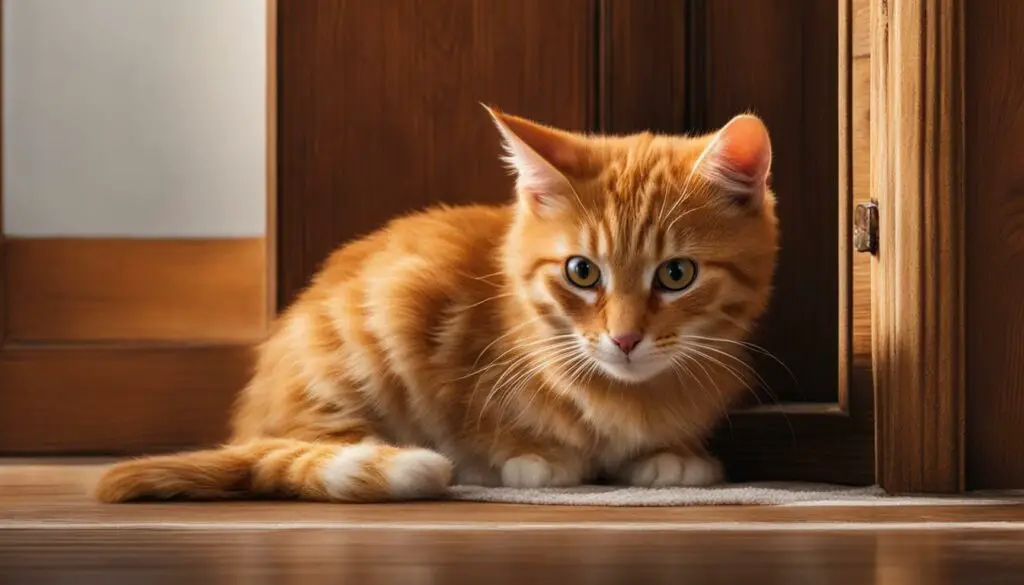Have you ever wondered why your cat cries relentlessly when locked out of the bedroom? It can be a perplexing behavior, but there are several reasons why our feline companions exhibit this behavior. Understanding the underlying factors can help us address their needs and create a harmonious living environment.
Cats often cry when locked out of the bedroom due to a combination of factors. Their curiosity drives them to know what lies beyond closed doors, while the feeling of being trapped can cause discomfort. Additionally, cats are social animals and want to be where their human companions are. Learned behavior and separation anxiety can also contribute to their distress vocalizations.
In this article, I will delve deeper into the reasons behind your cat’s cries when locked out of the bedroom and provide helpful insights on how to address their needs. By understanding their behavior and emotions, we can create a more understanding and fulfilling relationship with our feline friends.
Key Takeaways:
- Cats cry when locked out of the bedroom due to curiosity, feeling trapped, social needs, learned behavior, and separation anxiety.
- Addressing these factors through environmental enrichment, behavioral training, and creating a positive environment can help alleviate cat distress vocalizations.
- Persistent crying should not be ignored and may require veterinary consultation to determine the underlying cause.
- Allowing a cat in the bedroom at night has benefits and drawbacks that should be carefully considered based on individual circumstances.
- Providing environmental enrichment and opportunities for exploration can satisfy a cat’s curiosity and reduce vocalizations in response to closed doors.
Why are cats so curious about closed doors?
Cats are naturally curious creatures, and their curiosity often extends to closed doors. This behavior is driven by their innate desire to explore and investigate their surroundings. Closed doors represent a barrier that piques their interest, making them eager to discover what lies beyond. The curiosity of cats is a powerful motivator that compels them to meow and request access to the other side of the door.
Their inquisitive nature drives them to satisfy their curiosity and determine if the room behind the closed door offers new experiences or opportunities for exploration. Cats are known for their keen senses and desire to investigate every nook and cranny, making closed doors an enticing mystery for them to unravel.
Furthermore, cats may also be motivated by the fear of missing out. Being social animals, they want to be where the action is and feel included in their human companions’ activities. Closed doors separate them from the household hustle and bustle, leading to vocalizations as they seek social interaction and companionship. Their meowing is their way of expressing their desire to be a part of the action and rejoin their human family.

Why are cats so curious about closed doors?
“Cats are naturally curious creatures, and their curiosity often extends to closed doors.”
Understanding the curiosity of cats when it comes to closed doors can help cat owners manage their behavior more effectively. Providing controlled opportunities for exploration, such as supervised outdoor time or interactive toys, can help satisfy their curiosity and reduce vocalizations in response to closed doors. Additionally, creating a safe and stimulating environment indoors, filled with toys, scratching posts, and cat trees, can help channel their curiosity and provide mental stimulation.
| Reasons for Cat Curiosity about Closed Doors | Explanation |
|---|---|
| Exploration and investigation | Cats are naturally curious and want to know what lies beyond closed doors. |
| Fear of missing out | Cats are social animals and want to be where the action is, not missing out on any activities. |
| Keen senses and desire for new experiences | Cats have sharp senses and love exploring new environments, making closed doors an enticing mystery for them. |
By understanding and embracing their curiosity, cat owners can provide an enriched environment that satisfies their feline companion’s need for exploration and mental stimulation. This, in turn, can help reduce their vocalizations in response to closed doors, creating a more harmonious living arrangement for both cats and their owners.
How does feeling trapped contribute to a cat’s distress?
When a cat is confined to a small space, such as being locked out of a bedroom, it can experience feelings of being trapped and uncomfortable. This confinement can cause distress and lead to vocalizations, such as meowing, as a way of expressing their discomfort. Cats are naturally independent animals and prefer to have the freedom to move around and explore their environment. Being confined to one room limits their ability to roam and can create a sense of confinement, which can be distressing for them.
Feeling trapped can also trigger other negative emotions in cats. They may become anxious or stressed if they do not have access to their preferred hiding spots or if they feel restricted in their movements. This can manifest through vocalizations, restlessness, or other signs of distress. Cats are territorial creatures and being confined to a small space can disrupt their sense of territory and security.
In addition to feeling trapped physically, cats may also experience emotional distress when locked out of a bedroom. They are social animals and crave companionship and interaction with their human companions. Being separated from their owners can make them feel lonely and isolated, which can contribute to their distress. Vocalizations, such as meowing, can be a way for cats to signal their desire for attention and to be reunited with their loved ones.
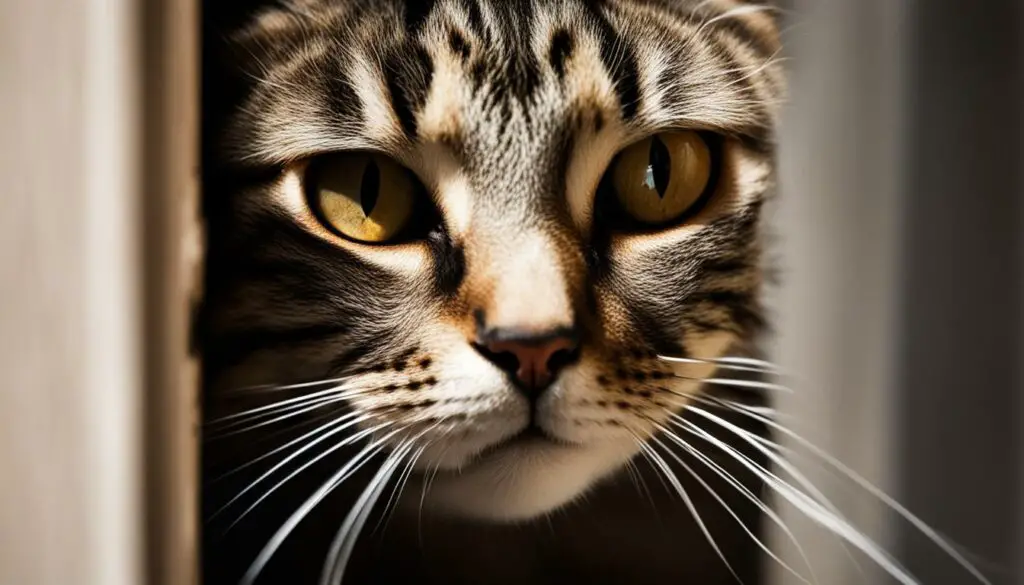
How to help a cat cope with confinement
To help a cat feel more comfortable when confined, it is important to provide them with a stimulating and enriching environment. This can include providing plenty of toys, scratching posts, and cozy hiding spots within the confined space. Creating a positive association with the room by offering treats or interactive play sessions can also help alleviate their distress.
Additionally, gradually acclimating a cat to being confined can help them adjust and reduce their anxiety. This can be done by starting with short periods of confinement and gradually increasing the duration over time. Providing familiar scents, such as their bedding or clothing with their owner’s scent, can also offer comfort and reassurance.
If a cat continues to exhibit distress vocalizations or shows signs of severe anxiety when locked out of the bedroom, it may be beneficial to consult with a veterinarian or a professional animal behaviorist. They can provide further guidance and recommendations on how to help the cat cope with confinement and reduce their distress.
The social aspect of cats and closed doors
Cats are known for their social nature and strong bond with their human companions. When a cat is locked out of a bedroom, it can trigger a fear of missing out (FOMO) and a desire to be where the action is. Cats want to be involved in the household activities and feel included in the family dynamic. This social aspect of cats plays a significant role in their vocalizations when separated from their owners.
A cat’s vocalizations when locked out of a bedroom can be their way of seeking attention and companionship. They may meow and cry to express their desire to rejoin their human family, particularly when they hear voices or activity coming from the other side of the door. This behavior is driven by their need for social interaction and a sense of belonging.
| Signs of a strong cat-human bond | Signs of distress vocalizations |
|---|---|
| Seeking physical contact and cuddling with their owner | Excessive meowing and crying when separated from their owner |
| Frequently purring and kneading on their owner’s lap | Pacing and restlessness when locked out of a room |
| Following their owner around the house | Scratching at the door and pawing at the handle |
Understanding the social nature of cats can help us address their distress vocalizations when locked out of the bedroom. Providing adequate social interaction, playtime, and affection can help cats feel more secure and content, reducing their anxiety and need to vocalize. Creating a positive environment where they have access to toys, scratching posts, and cozy spots to rest can also keep them engaged and satisfied.
Learned Behavior and the Association Between Meowing and Door Opening
When it comes to cats crying when locked out of the bedroom, learned behavior plays a significant role. Cats are intelligent animals and can quickly learn through association and reinforcement. If a cat has learned that meowing leads to their owner opening the door, they may continue the behavior to achieve the desired outcome.
Through consistent responses, caregivers can break the cycle of meowing and door opening. It’s essential to only open the door when the cat is calm and quiet, teaching them that vocalizing does not result in the desired outcome. This helps them understand that meowing is not an effective strategy for getting what they want.
“Cats are incredibly intuitive and can pick up on patterns. If they have learned that meowing leads to the door being opened, they will continue to vocalize to achieve that result,” explains Dr. Emily Thompson, a feline behavior specialist. “By reinforcing calm behavior, we can help redirect their attention and reduce excessive vocalizations.”
Implementing positive reinforcement techniques, such as offering treats or praise for quiet behavior, can help strengthen the association between silence and door opening. Over time, the cat will learn that being calm and quiet is more effective than meowing when trying to gain access to a closed door area.

| Behavior | Response |
|---|---|
| Meowing | No response from caregiver |
| Calm and quiet behavior | Opening the door |
| Continued meowing | No response from caregiver |
By focusing on positive reinforcement and redirecting the cat’s attention, we can help them understand that meowing is not an effective strategy for gaining access to closed areas. Consistency and patience are key in breaking the cycle of learned behavior and reducing excessive vocalizations.
Understanding separation anxiety in cats
Separation anxiety is a common issue that many cats experience when separated from their owners. Just like humans, cats can form strong emotional bonds, and when they are left alone, they may feel anxious and distressed. This anxiety can manifest in various ways, including excessive vocalizations such as meowing or crying. Understanding separation anxiety in cats is crucial for providing them with the support and care they need.
Cats who experience separation anxiety may display signs of distress when separated from their owners. They may exhibit behaviors such as pacing, excessive grooming, or even destructive behaviors like scratching furniture or urinating outside the litter box. These behaviors are their way of coping with the anxiety and trying to seek comfort.
Recognizing the signs of separation anxiety
It’s important for cat owners to be able to recognize the signs of separation anxiety in their feline companions. Some common signs include:
- Excessive vocalizations, such as meowing or crying
- Changes in appetite or refusing to eat
- Restlessness or pacing
- Excessive grooming or pulling out fur
- Destructive behaviors, such as scratching furniture or chewing on objects
If you notice any of these signs in your cat when they are separated from you, it’s essential to address their anxiety and provide them with the necessary support.
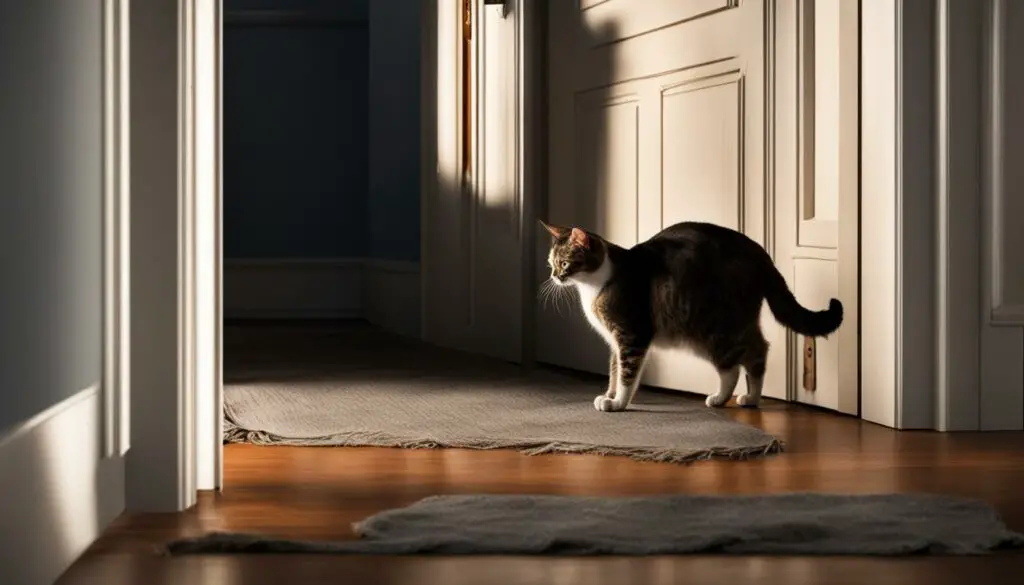
How to Help Cats Feel More Comfortable with Closed Doors
Creating a positive environment and providing training can significantly help cats feel more comfortable with closed doors. Here are some strategies to consider:
- Gradual acclimation: Introduce your cat to closed doors gradually, starting with short periods of confinement and gradually increasing the duration. This allows them to adjust to the idea of being separated and helps reduce anxiety.
- Positive reinforcement: Reward your cat with treats and praise when they remain calm and quiet near closed doors. Positive reinforcement helps them associate calm behavior with positive experiences, reinforcing good habits.
- Creating a safe space: Ensure the room or area where your cat is confined has all the essentials they need. Provide a comfortable bed, litter box, food, water, and toys. This helps them feel secure and reduces stress.
- Environmental enrichment: Engage your cat with interactive toys, scratching posts, and puzzle feeders. This keeps them mentally stimulated and helps alleviate boredom and frustration that can trigger vocalizations.
Remember, each cat is unique, and what works for one may not work for another. Be patient and consistent in your approach, and consult with a veterinarian or a professional cat behaviorist if you’re facing specific challenges.
The importance of addressing persistent crying
When it comes to cats crying when locked out of the bedroom, it’s important not to ignore their distress vocalizations. Persistent crying can be a sign that something is wrong and should be addressed. Cats communicate through meowing, and excessive vocalization can indicate stress or discomfort. If your cat’s behavior suddenly changes and they begin to cry excessively, or if they exhibit signs of distress such as hypersalivation, vomiting, diarrhea, or panting, it could be a cause for concern.
Addressing the underlying cause of the distress vocalizations is crucial for your cat’s well-being. It’s recommended to open the door and schedule an appointment with a veterinarian or a veterinary behaviorist to determine the cause of the crying. A professional can assess your cat’s behavior, rule out any medical conditions, and offer guidance on how to alleviate the distress. Remember, cats rely on us to understand and address their needs, so it’s important not to dismiss their cries for help.
By identifying and addressing the root cause of the distress vocalizations, you can help your cat feel more comfortable and secure. Whether it’s separation anxiety, fear of missing out, or a learned behavior, understanding the why behind their crying is key to finding a solution. With the help of a professional and through environmental enrichment, behavioral training, and creating a positive environment, you can help alleviate your cat’s distress and create a harmonious living arrangement for both of you.
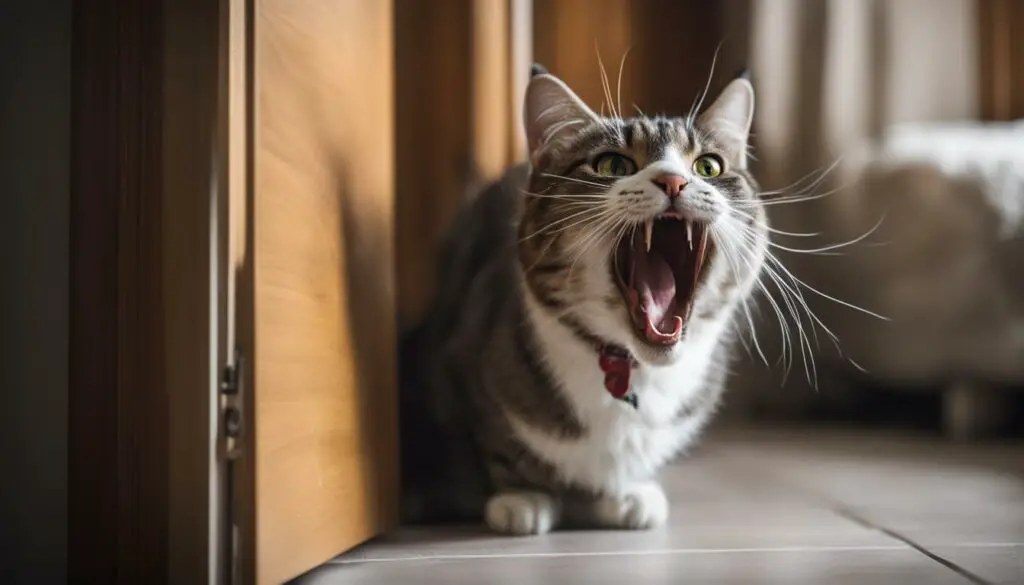
Remember, if your cat is persistently crying when locked out of the bedroom, it’s important to address their distress and seek professional advice if necessary. Your cat’s well-being depends on it.
The potential consequences of allowing a cat in the bedroom at night
Allowing a cat into the bedroom at night can have both benefits and drawbacks. While it can foster a sense of companionship and security, it’s important to consider the potential consequences. Cats are known to be active during the night, and their behavior can disrupt sleep patterns. They may engage in playfulness, vocalize loudly, or scratch furniture, which can disturb your rest. Sleep disruption can have a negative impact on your overall well-being, affecting your mood, productivity, and overall quality of life.

Additionally, if you or a family member is allergic to cats, allowing them in the bedroom can exacerbate allergy symptoms. Cats produce allergens, such as dander and saliva, which can trigger allergic reactions. These reactions can include itchy eyes, sneezing, congestion, and even difficulty breathing for those with severe allergies. It’s important to consider the health and comfort of everyone in your household when deciding whether or not to allow a cat in the bedroom at night.
When making this decision, it’s crucial to weigh the pros and cons based on your personal circumstances. If you’re concerned about sleep disruption or allergies, you may choose to keep the bedroom cat-free and provide alternative sleeping arrangements for your feline companion. This could include setting up a comfortable sleeping area in another part of the house, complete with a cozy bed, toys, and familiar items that provide a sense of security.
Creating a peaceful sleep environment for both you and your cat
If you do decide to allow your cat in the bedroom at night, there are steps you can take to minimize sleep disturbances and allergy symptoms. Consider implementing the following strategies:
- Establish a routine: Cats thrive on routine, so incorporating a consistent bedtime routine can help signal to your furry friend that it’s time to settle down for the night.
- Create a cozy sleeping spot: Provide your cat with a comfortable bed or blanket in a designated area of the bedroom, away from your own sleeping space. This can help establish boundaries and reduce the likelihood of disturbances during the night.
- Play and exercise: Engaging in a play session with your cat before bedtime can help tire them out and promote a more restful night’s sleep.
- Invest in a high-quality air purifier: An air purifier with a HEPA filter can help remove allergens from the air, reducing the risk of allergy symptoms.
- Regular grooming: Regularly grooming your cat can help reduce the amount of allergens they carry on their fur.
By considering these factors and taking appropriate measures, you can create a sleep environment that accommodates both you and your feline companion, promoting a peaceful night’s rest for everyone involved.
The importance of environmental enrichment for cats
Cats are curious, intelligent creatures that require mental stimulation and engagement to thrive. Environmental enrichment plays a critical role in preventing boredom and promoting overall well-being in cats. Providing a variety of stimulating activities and opportunities for exploration can help alleviate behavioral issues, including excessive vocalizations like crying when locked out of the bedroom.
One effective way to enrich a cat’s environment is by offering interactive toys that encourage mental and physical engagement. Puzzle feeders, for example, can provide both mental stimulation and a rewarding challenge during mealtime. These toys require cats to work for their food, mimicking their natural hunting instincts and helping keep boredom at bay.
In addition to interactive toys, cat trees and scratching posts offer opportunities for exercise and play. Cats can use these structures to climb, scratch, and explore their surroundings. This not only provides physical exercise but also helps satisfy their natural need for vertical space, which can reduce stress and promote a sense of security.
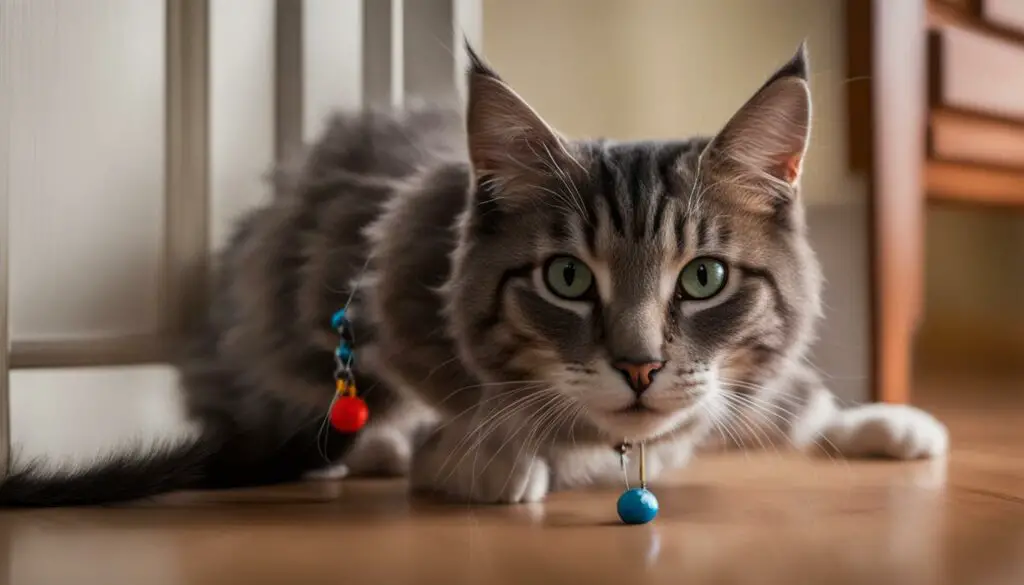
Creating a stimulating environment
Creating a stimulating environment for your cat involves more than just providing toys and scratching posts. It’s important to consider their individual preferences and needs. Some cats may enjoy hiding spots, while others may prefer elevated perches to observe their surroundings. By observing your cat’s behavior and preferences, you can tailor their environment to suit their specific needs.
Rotating toys and offering new ones periodically can also help prevent boredom. Cats are naturally curious creatures, and introducing novel items can keep them engaged and prevent them from losing interest in their surroundings. Additionally, incorporating safe outdoor access, such as through a secure catio or supervised outdoor time, can provide cats with the opportunity to explore new scents, sights, and sounds.
The benefits of environmental enrichment
Providing environmental enrichment for cats offers numerous benefits. It helps prevent behavioral issues, such as excessive vocalizations and destructive behavior, by keeping cats mentally stimulated and engaged. Enrichment activities also promote physical exercise, which is essential for maintaining a healthy weight and preventing obesity-related health problems.
Beyond the physical and mental benefits, environmental enrichment can strengthen the bond between cats and their owners. Interactive play sessions, for example, provide opportunities for positive interaction and can help build trust and companionship. By investing time and effort into creating an enriching environment for your cat, you are not only enhancing their quality of life but also fostering a deeper connection with them.
Understanding territorial behavior in cats
When it comes to our feline companions, understanding their territorial behavior is crucial in creating a harmonious living environment. Cats are naturally territorial animals, and closed doors can disrupt their sense of territory, leading to distress vocalizations. By recognizing and addressing their territorial needs, we can help alleviate their stress and reduce excessive vocalization in response to closed doors.
The Significance of Marking Behavior
One way cats establish and maintain their territory is through marking behavior. Scent-marking is a common method used by cats to communicate their presence and ownership. They do this by depositing pheromones through rubbing their bodies or scratching on objects in their territory. This behavior helps create a familiar and comforting environment for them. When faced with a closed door, cats may vocalize as a way of asserting their presence and marking their territory, indicating a desire to explore and protect their space.
Providing Scent-Marking Opportunities
To help alleviate territorial stress and reduce vocalizations, it is essential to provide cats with multiple designated spaces for scent-marking. This can be achieved by placing scratching posts and vertical territory markers such as cat trees in different areas of the home. Additionally, allowing access to safe outdoor spaces, like enclosed gardens or catio designs, can provide cats with opportunities to mark their territory and satisfy their territorial instincts. By offering these scent-marking opportunities, we can help cats establish a sense of ownership and security, reducing their need for excessive vocalization.

Creating a Calm and Secure Environment
In addition to providing scent-marking opportunities, creating a calm and secure environment is essential in addressing territorial behavior in cats. Ensuring that each cat has their own space within the home can help minimize territorial conflicts. This can be achieved by providing separate litter boxes, feeding areas, and resting spots for each cat. Additionally, using pheromone diffusers or sprays, such as Feliway, can help create a calming and familiar atmosphere, reducing stress and territorial tension.
Understanding and addressing territorial behavior in cats is key to fostering a peaceful living environment. By recognizing the significance of marking behavior, providing scent-marking opportunities, and creating a calm and secure environment, we can help our feline companions feel more at ease and reduce their need for excessive vocalization in response to closed doors.
The Curiosity Factor in Cats
Cats are known for their innate curiosity and desire to explore new spaces. When faced with closed doors, their curiosity is piqued, and they may exhibit behaviors such as crying or meowing in an attempt to satisfy their inquisitive nature. This behavior is a reflection of their desire to explore and investigate their surroundings.
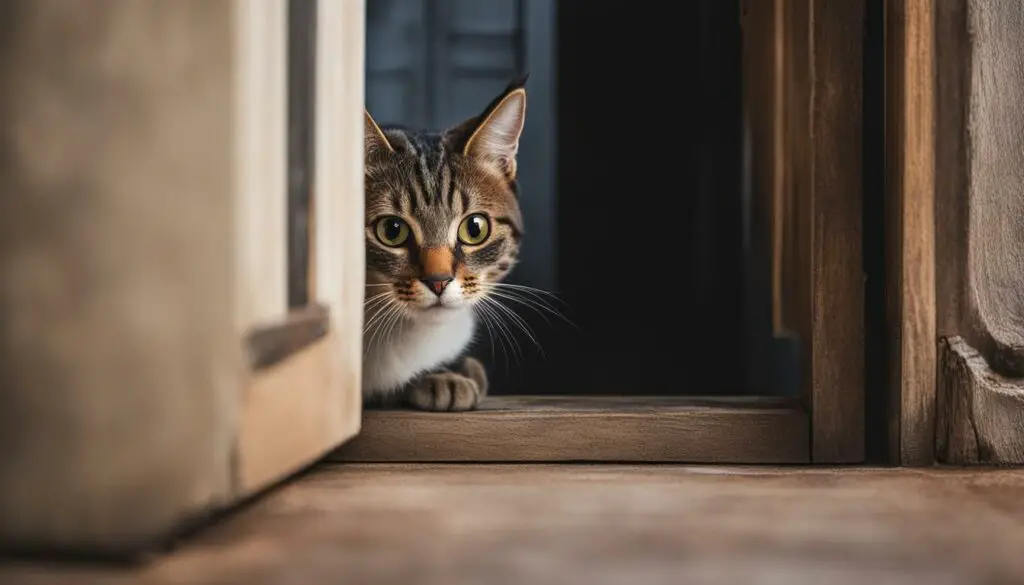
It is essential to provide controlled opportunities for cats to explore new spaces and satisfy their curiosity. This can be done by creating a safe and enriching environment that stimulates their senses and encourages exploration. Interactive toys, scratching posts, and vertical spaces such as cat trees can provide outlets for their natural instincts and keep them mentally stimulated.
Additionally, supervised outdoor time can allow cats to explore the outside world while ensuring their safety. However, it is crucial to consider the risks associated with outdoor exploration, such as exposure to potential dangers or the transmission of diseases.
Offering a variety of stimulating environments and toys can help keep cats entertained and prevent them from becoming bored or frustrated. It is important to remember that every cat is unique, and their curiosity may manifest differently. By understanding their individual needs and providing appropriate outlets for their curiosity, we can help create a happy and fulfilled feline companion.
The Importance of Environmental Enrichment
Incorporating environmental enrichment into a cat’s daily routine is crucial for their overall well-being. It helps prevent boredom and destructive behavior while promoting mental stimulation and physical exercise. Providing a stimulating environment that encourages exploration and satisfies their curiosity is key to keeping cats happy and content.
Table: Creating a Stimulating Environment for Cats
| Environmental Enrichment | Description |
|---|---|
| Interactive Toys | Provide toys that require active engagement, such as puzzle feeders or interactive wand toys. These toys stimulate a cat’s hunting instincts and keep them mentally engaged. |
| Vertical Spaces | Invest in cat trees or shelves that allow cats to climb, perch, and observe their surroundings from a higher vantage point. Vertical spaces provide cats with a sense of security and territory. |
| Scratching Posts | Offer multiple scratching posts or boards to fulfill a cat’s natural instinct to scratch and stretch. This helps keep their claws healthy and prevents them from damaging furniture. |
| Safe Outdoor Enclosures | If possible, create a secure outdoor enclosure or provide access to a screened-in porch. This allows cats to experience the sights, sounds, and smells of the outdoors without the risks associated with free-roaming. |
Remember, each cat is unique, and their curiosity levels may vary. Paying attention to their individual needs and providing ample opportunities for exploration and mental stimulation will help ensure their well-being and keep them entertained.
Conclusion
In conclusion, understanding and addressing cat distress vocalizations when locked out of the bedroom is crucial for both the well-being of our feline companions and our own peace of mind. By considering factors such as cat behavior, vocalizations, and addressing their distress, we can create a harmonious living arrangement.
Environmental enrichment plays a significant role in keeping cats mentally stimulated, satisfied, and less likely to cry when separated from their owners. Providing toys, scratching posts, and interactive play sessions can help alleviate boredom and anxiety. Moreover, creating a positive environment in the confined space can make it more comfortable and enjoyable for our cats.
It is essential to understand that persistent crying should not be ignored. If a cat’s distress vocalizations persist or they exhibit signs of stress, it is advisable to seek professional advice from a veterinarian or a veterinary behaviorist. They can help determine any underlying health or behavioral issues and provide appropriate guidance and solutions.
Ultimately, finding the right balance between allowing a cat in the bedroom at night and ensuring a good night’s sleep is a personal decision. Considering factors such as allergies, disruptive behaviors, and individual circumstances can help make an informed choice. Remember, addressing cat distress and providing a loving and enriching environment is key to fostering a strong bond and a happy life together.
FAQ
Why do cats cry when locked out of the bedroom?
Cats cry when locked out of the bedroom due to a combination of factors, including curiosity, feeling trapped, wanting to be where the action is, learned behavior, and separation anxiety.
Why are cats so curious about closed doors?
Cats are naturally curious creatures and want to explore and investigate what lies beyond the closed door. Curiosity is a strong motivator for cats to meow and request access to the other side of the door.
How does feeling trapped contribute to a cat’s distress?
Cats can feel trapped and uncomfortable when confined to one room. Feeling trapped can cause distress and prompt cats to meow as a way of communicating their discomfort and desire for freedom.
What is the social aspect of cats and closed doors?
Cats are social animals and want to be where their human companions are. They may cry to express a fear of missing out and seek social interaction and companionship.
How does learned behavior and the association between meowing and door opening play a role?
Cats can learn that meowing leads to the door being opened when their owners consistently respond to their meowing. This learned behavior can reinforce their vocalizations when locked out of the bedroom.
What is separation anxiety in cats?
Some cats may experience separation anxiety when separated from their owners, leading to distress vocalizations when locked out of the bedroom. Gradual desensitization and comfort techniques can help alleviate separation anxiety.
How can I help cats feel more comfortable with closed doors?
Creating a positive environment in the room they are confined to, gradually acclimating them to closed doors, and providing comfort through familiar scents can help alleviate their stress and reduce vocalizations.
Why should persistent crying be addressed?
Persistent crying from a cat when locked out of the bedroom should not be ignored. It may indicate underlying distress or health issues that require attention from a veterinarian or a veterinary behaviorist.
What are the potential consequences of allowing a cat in the bedroom at night?
Allowing a cat in the bedroom at night can provide a sense of companionship but may also result in disruptive behaviors and exacerbate allergies. Consider individual circumstances when deciding whether to allow a cat in the bedroom at night.
How important is environmental enrichment for cats?
Environmental enrichment is crucial to prevent boredom and disruptive behaviors in cats. Providing toys, play sessions, and mental stimulation can keep cats entertained and satisfied.
What is territorial behavior in cats?
Cats are territorial animals, and closed doors can disrupt their sense of territory. They may cry to assert their presence and mark their territory. Providing designated spaces and scent-marking opportunities can help alleviate territorial stress.
Why are cats so curious?
Cats have a natural curiosity, and closed doors pique their interest. They may cry as a way of expressing their curiosity about the space beyond the closed door. Providing controlled opportunities for exploration can help satisfy their curiosity.
What is the importance of understanding cat vocalizations?
Understanding the reasons behind cat vocalizations when locked out of the bedroom can help address their specific needs and emotions. This knowledge is crucial for creating a harmonious living arrangement for both cats and their owners.
Source Links
- https://be.chewy.com/is-this-normal-why-do-cats-hate-closed-doors/
- https://www.reddit.com/r/CatAdvice/comments/gano2t/my_cat_wont_stop_crying_outside_my_bedroom_door/
- https://guidedpet.com/cat-cries-when-locked-out-of-bedroom/

